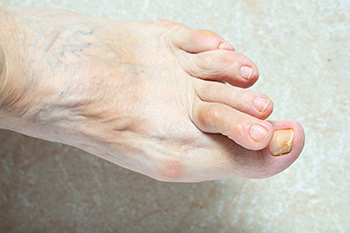
Hammertoe, a podiatric condition, unfolds as a deformity affecting the toes, altering their natural alignment. This ailment is characterized by a bending of the toe joints, resembling the shape of a hammer. The condition most commonly affects the second toe, but any toe can undergo this deformity over time. The root causes of hammertoe often stem from an imbalance in the muscles and tendons that normally keep toes straight. Shoes with inadequate space and high heels can exert pressure, forcing the toes into abnormal positions. Moreover, genetic predispositions and foot structure anomalies contribute to the development of hammertoe. Arthritis and other systemic diseases may exacerbate the risk. The progression of hammertoe typically unfolds gradually, starting with mild bending and progressing to fixed deformities if left untreated. Recognizing the definition and causes of hammertoe is essential for early intervention and the implementation of preventative measures, underscoring the importance of wearing proper footwear and having regular foot examinations. If you have symptoms of hammertoe, it is strongly suggested that you schedule an appointment with a podiatrist who can offer treatment methods that are right for you.
Hammertoe
Hammertoes can be a painful condition to live with. For more information, contact Dr. Tupper from Coshocton Foot Health Center. Our doctor will answer any of your foot- and ankle-related questions.
Hammertoe is a foot deformity that affects the joints of the second, third, fourth, or fifth toes of your feet. It is a painful foot condition in which these toes curl and arch up, which can often lead to pain when wearing footwear.
Symptoms
- Pain in the affected toes
- Development of corns or calluses due to friction
- Inflammation
- Redness
- Contracture of the toes
Causes
Genetics – People who are genetically predisposed to hammertoe are often more susceptible
Arthritis – Because arthritis affects the joints in your toes, further deformities stemming from arthritis can occur
Trauma – Direct trauma to the toes could potentially lead to hammertoe
Ill-fitting shoes – Undue pressure on the front of the toes from ill-fitting shoes can potentially lead to the development of hammertoe
Treatment
Orthotics – Custom made inserts can be used to help relieve pressure placed on the toes and therefore relieve some of the pain associated with it
Medications – Oral medications such as anti-inflammatories or NSAIDs could be used to treat the pain and inflammation hammertoes causes. Injections of corticosteroids are also sometimes used
Surgery – In more severe cases where the hammertoes have become more rigid, foot surgery is a potential option
If you have any questions please contact our office located in Coshocton, OH . We offer the newest diagnostic and treatment technologies for all your foot and ankle needs.
